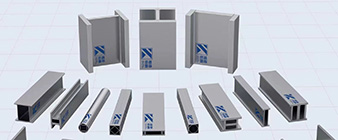This is a general overview of using stainless steel for structural beams and columns:
Material grade:
The most commonly used stainless steel grades for structural applications are austenitic grades such as 304 (EN 1.4301) and 316 (EN 1.4401).
These grades provide a good balance of strength, ductility and corrosion resistance.
Double-stranded stainless steels, such as 2205 (EN 1.4462), are also sometimes used for their higher strength and corrosion resistance.
Mechanical Properties:
Stainless steel has a higher strength-to-weight ratio than carbon steel, making it suitable for structural applications.
Typical tensile strengths vary from 500 to 700 MPa, with yield strengths ranging from 200 to 500 MPa depending on the grade.
Stainless steel also exhibits good ductility, with crack elongation typically around 30-50%.
Corrosion resistance:
Stainless steel is highly resistant to corrosion, which is an important advantage for structural applications in harsh environments.
The chromium content in stainless steel creates a passive, self-healing oxide layer that protects the metal underneath.
Higher synthetic grades, such as 316 (EN 1.4401), have enhanced resistance to dent and crevice corrosion.
Fabrication and welding:
Stainless steel structural members can be manufactured using a variety of techniques, including rolling, bending and welding.
Welding of stainless steel requires careful control of parameters to maintain the material’s corrosive properties and mechanical properties in the heated area.
Design considerations:
Stainless steel structural design follows similar principles to carbon steel, with some adjustments made to account for the material’s unique properties.
Design codes such as Eurocode 3 (EN 1993) and AISC 360 provide guidance on the design of stainless steel structures.
Factors such as local and global buckling, deflection and connection design must be carefully considered.
Stainless steel structural beams and columns are used in a wide range of applications, including:
Bridges and Overpasses
Construct facades and canopies
Industrial facilities such as chemical plants and food processing plants
Marine and Coastal Structures
Architectural and decorative elements
The selection of stainless steel grades for structural applications depends on the specific requirements of the project, such as the anticipated corrosive environment, load-bearing needs and cost considerations. Consultation with structural engineers and materials experts is recommended to ensure appropriate selection and design of stainless steel structural components.
-
 2024-9-25 1.4301 Stainless Steel Structural Profile Performance
2024-9-25 1.4301 Stainless Steel Structural Profile Performance -
 2024-9-20 Application of Ti Gr 7/3.7235/UNS R52400 Structural Stations
2024-9-20 Application of Ti Gr 7/3.7235/UNS R52400 Structural Stations -
 2024-9-25 UNS N08926 Super Stainless Steel Structural Profiles
2024-9-25 UNS N08926 Super Stainless Steel Structural Profiles -
 2024-1-02 Laser welded stainless steel structural Section
2024-1-02 Laser welded stainless steel structural Section -
 2024-9-16 2205 duplex stainless steel in bridges of Innovative application
2024-9-16 2205 duplex stainless steel in bridges of Innovative application -
2024-1-10 Stainless Steel – Austenitic – 1.4404 (316L) Bar and structural Section
-
 2024-9-29 Alloy 602 CA / 2.4633/N06025 Nickel-based alloy hollow structural profiles
2024-9-29 Alloy 602 CA / 2.4633/N06025 Nickel-based alloy hollow structural profiles



